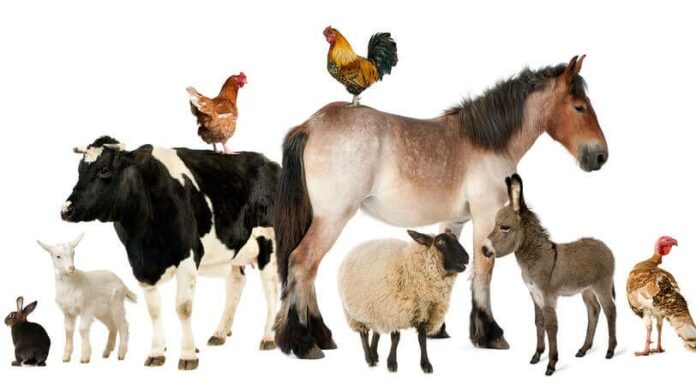MOTHERLAND IS TACKLING WITH LSD
ABSTRACT:
This report is about an calf which is affected with lumpy skin disease. Animal came into clinical complex with cutaneous nodules all over the body from past 4 days. It has weak demeanour with emaciated condition. On physical examination, it shows Sunken eyes, nodular appearance of lesions on the skin and swollen pre scapular and pre femoral lymph nodes. Based on history and thorough clinical evaluation, as there is no specific treatment available, but prevention of secondary infection has been done by supportive treatment. Without any complications, the animal came back to normal condition.
Key words:lumpy skin disease,Neethling pox virus,lymphadenitis.
INTRODUCTION:
Lumpy skin disease is an acute febrile disease of cattle which is characterised by eruption of skin nodules of various sizes{S.N.SHARMA and S.C.ADLAKHA,2009}.It is a severe, systemic disease of cattle associated with the “NEETHLING” pox virus, a capri pox virus {O.M.RADOSTITS, et al.,2009}. It is mainly transmitted by Air borne, biting fly, agro-climates and it has the incubation period of 4 to 14days.animal will expose the diseased condition by clinical symptoms like high rise in temperature, nasal discharges, lameness, reduce in milk production, pneumonia, brisket edema and abortion occur among pregnant animals. Generalized lymphadenitis and edema of the limbs are common.
Lumpy skin disease confirmation can be done by laboratory diagnosis based on demonstration of intracytoplasmic inclusions in the skin lesions, presence of virus particle by negative staining electron microscopy, detection of the viral antigen, isolation and demonstration of virus specific antibodies{DILIP.K.SARMA,2004}.Normally the morbidity rate varies from 5-15% but mortality rate never exceeds 10 percent .
Lumpy skin disease is rapidly spreading disease in India with reported mortality of the current outbreak in India is upto 15%, particularly in cases been reported in the country with above 18.5 lakh bovines are affected across the country of these, 12.5 lakh cases are only from Rajasthan.
HISTORY:
A calf of 8 years came to Teaching veterinary clinical complex ,Korutla, CVSc .Owner reported that animal has cutaneous nodular lesions all over the body and swollen pre scapular and pre femoral lymph nodes.A detailed physical examination was evaluated and vital signs are taken as: Temperature 104.5°F,Conjunctival mucous membrane pink, feed intake reduced, swelling in the limbs and nodules on the skin(Fig.1).Animal is in emaciated condition.
TREATMENT:
EMERGENCY MANAGEMENT AND TREATMENT OF LUMPY SKIN DISEASES (LSD) IN CATTLE IS DONE BY:
Firstly we should separate the infected animal to reduce the spread of virus to another animals.Animal should be placed in lateral recumbency. The main treatment procedure for the LSD is by reducing the secondary infection by treating with normal saline Nacl-0.9% solution and injection of wocktrose-25 intravenously. Dexamethasone@5ml which is an corticosteroid used to lessen the swollen pre scapular and pre femoral lymph nodes and it acts as anti-inflammatory drug for the nodular lesions.In order to decrease bacterial infection fortivir @200mg and multivitamin Tribivet @20ml given to stabilize the health of the animal.Antihistamine Chlorphenamine @ 10ml given intramuscularly which controls allergies associated with LSD.
After bring down the secondary infection, owner has been adviced to use herbal solutions…such as Healon for skin healing.Restobal appetite and digestive tonic used to enhance immunity and rumen functions. Energy boosters such as Enerdyna and Neem oil used to minimize the appearance of nodular lesions.Post care has been taken by the owner and animal came to normal condition.
RESULT AND DISCUSSION:
Quarantine (movement control), Vaccination,Slaughter campaigns & management strategies are very important in control and prevention.Awareness for LSD are of utmost necessity to tackle the production loss.Cattle and buffaloes should be vaccinated with available Goat pox vaccine (cattle and buffalo at the age of 4 months and above through S/C route with GTPV raccine (Uttarkashi strain) .Hence, homologous (Neethling LSDV strain) and heterologous (sheep pox or goat pox virus) live attenuated vaccines can all be used to protect cattle against LSD infection .Marked recovery was observed by above treatment.

REFERENCES:
Textbook of Veterinary virology S.N Sharma,S.C Adlakha 2009.
A Textbook of Veterinary virology and viral diseases Dilip K.sarma 2004
Veterinary Medicine A textbook of the diseases of cattle,sheep,horses,pigs,and goats Otto M Radostis,Clive C Gay,Kenneth W Hinchcliff,Peter D constable.
Fenners Veterinary Virology N.James MacLachlan&Edward J.Dubovi


